Stamp collecting is not wholly pursued by bookish types armed with magnifying glasses and tweezers. Queen Elizabeth II has been collecting ‘First-Day cover envelopes’ bearing stamps cancelled on their first day of issue since 1952.
Freddie Mercury, leader of the musical group Queen, collected stamps as a child. After his death, Mercury’s father sold Freddie’s collection to the Royal Mail, and proceeds were donated to an AIDS charity.
Now, textile artist and collector Jette Clover is using her own stamp collection as the foundation for a remarkable art series called ‘Small Notes’.
Jette creates small hand-stitched collages focusing on favourite personalities in her collection, including politicians, musicians, celebrities and more. These small collages pack powerful emotion through colour, composition, and of course, the actual stamp that is housed in each piece
Understanding Jette just completed collage Number 365 featuring singer Marvin Gaye gives you a feel for the immensity of both her stamp collection and her body of work
Jette has been kind enough to let us in on her creative process. And we think you’ll find both her planning and techniques fascinating, including self-imposed ‘rules’ and purposeful use of ‘limitations’ in her materials.
This is a story of how a personal collection can grow to become a global artistic gift.
Jette grew up in Copenhagen, Denmark. She worked as a journalist on a daily newspaper in Copenhagen for five years before marrying an American jazz musician and moving to America. Jette had been spinning, dyeing and weaving as a hobby during the Flower Power period of the ’70s, and wanted to study textile art. But because textile departments were largely about science and techniques, she instead achieved a Masters in Art History. She ran a fibre art gallery in Los Angeles, CA, (USA) and taught art history at a university in Seattle for five years.
Jette moved to the Netherlands in 1981, where she organised exhibitions and educational programs for the Dutch Textile Museum for more than 10 years. She currently lives in Belgium. She has exhibited widely in the USA, Europe, Asia and Australia. She has also taught across the globe and has published three books about her work. She has been a member of Quilt Art since 2000.
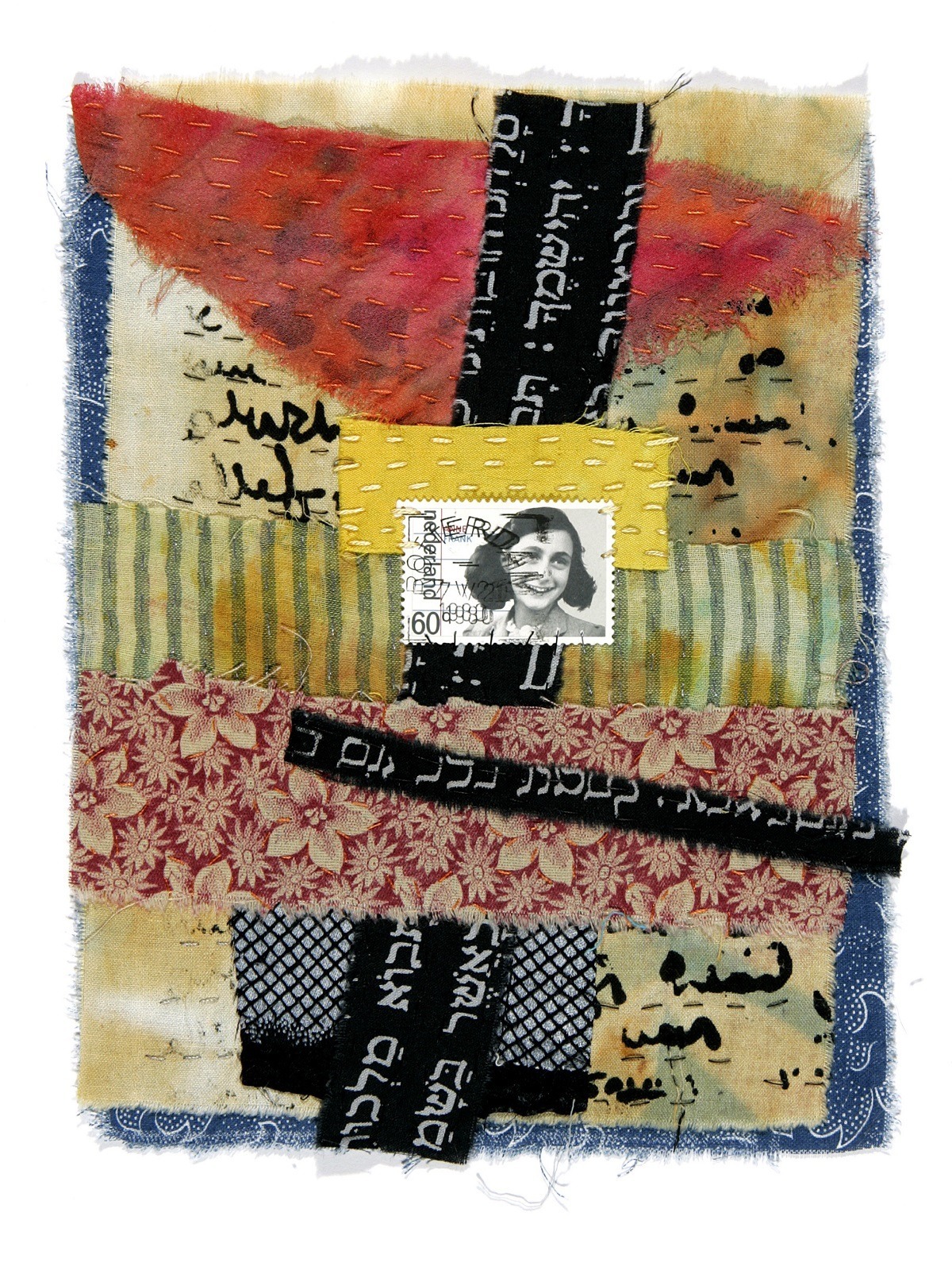
Still tearing stamps off envelopes
TextileArtist.org: How did the idea for the series come about? What was your inspiration?
Jette Clover: Moving is great for clearing your physical and mental space, finding forgotten treasures and rekindling old passions.
When we were moving from the Netherlands to America in 2000, I came across two shoe boxes and a dozen big envelopes full of postage stamps. I was a serious stamp collector as a child and had pen pals in several countries. I took great pleasure in sorting and categorising the little pictures into groups of animals, flowers, landscapes, Christmas, etc.
I am still a dedicated letter writer, and I still tear the stamps off envelopes and save them.
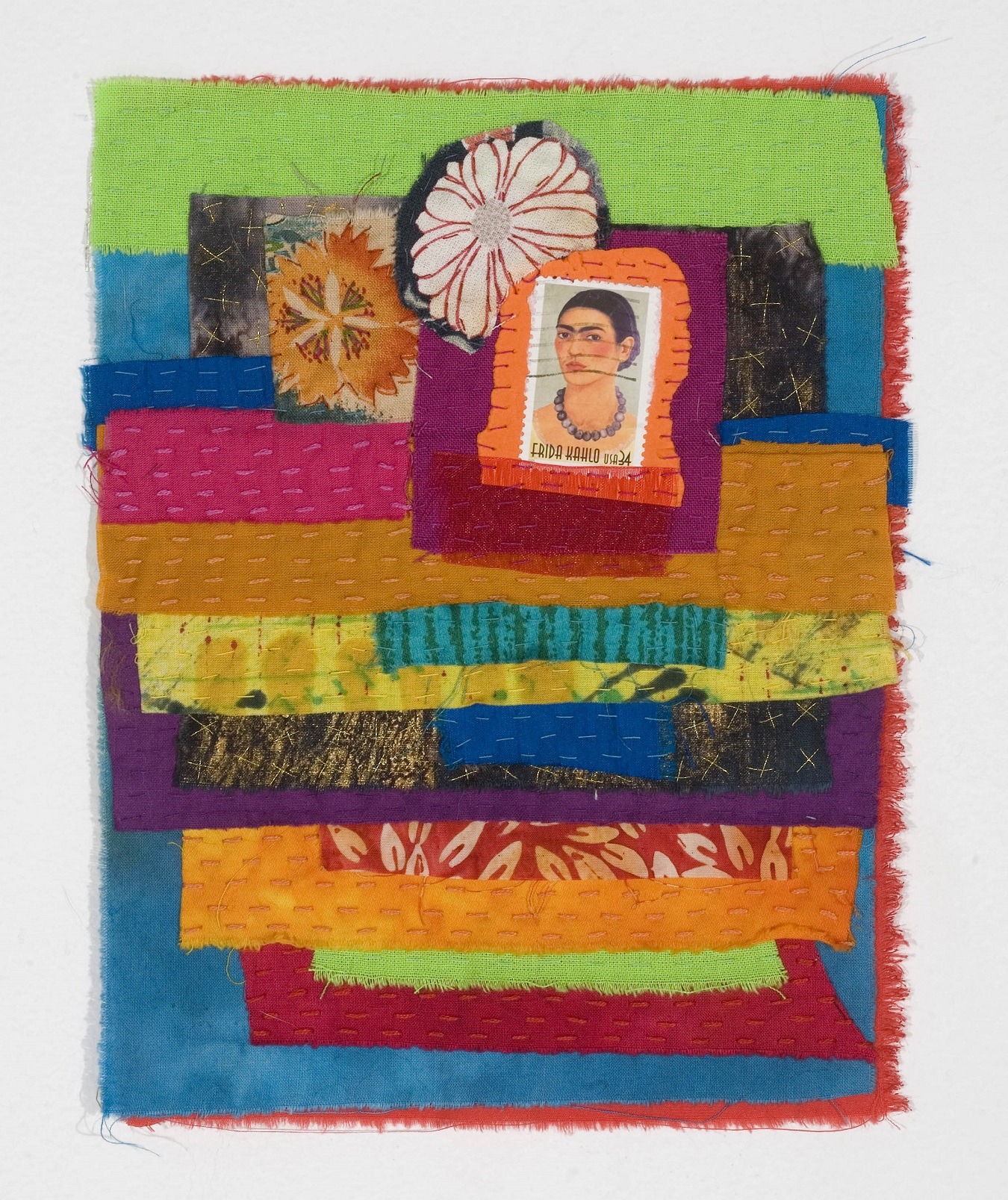
Looking at my overwhelming collection, I discovered I had a lot of stamps with famous people. Small portraits of people distinguishing themselves in one field or another: movie stars, musicians, writers, artists, athletes, politicians, scientists and more.
Art history has a long tradition of portraiture, and I decided to use these stamps of distinguished people as a direct source of inspiration for a series of small fabric collages that I would call ‘Small Notes.’
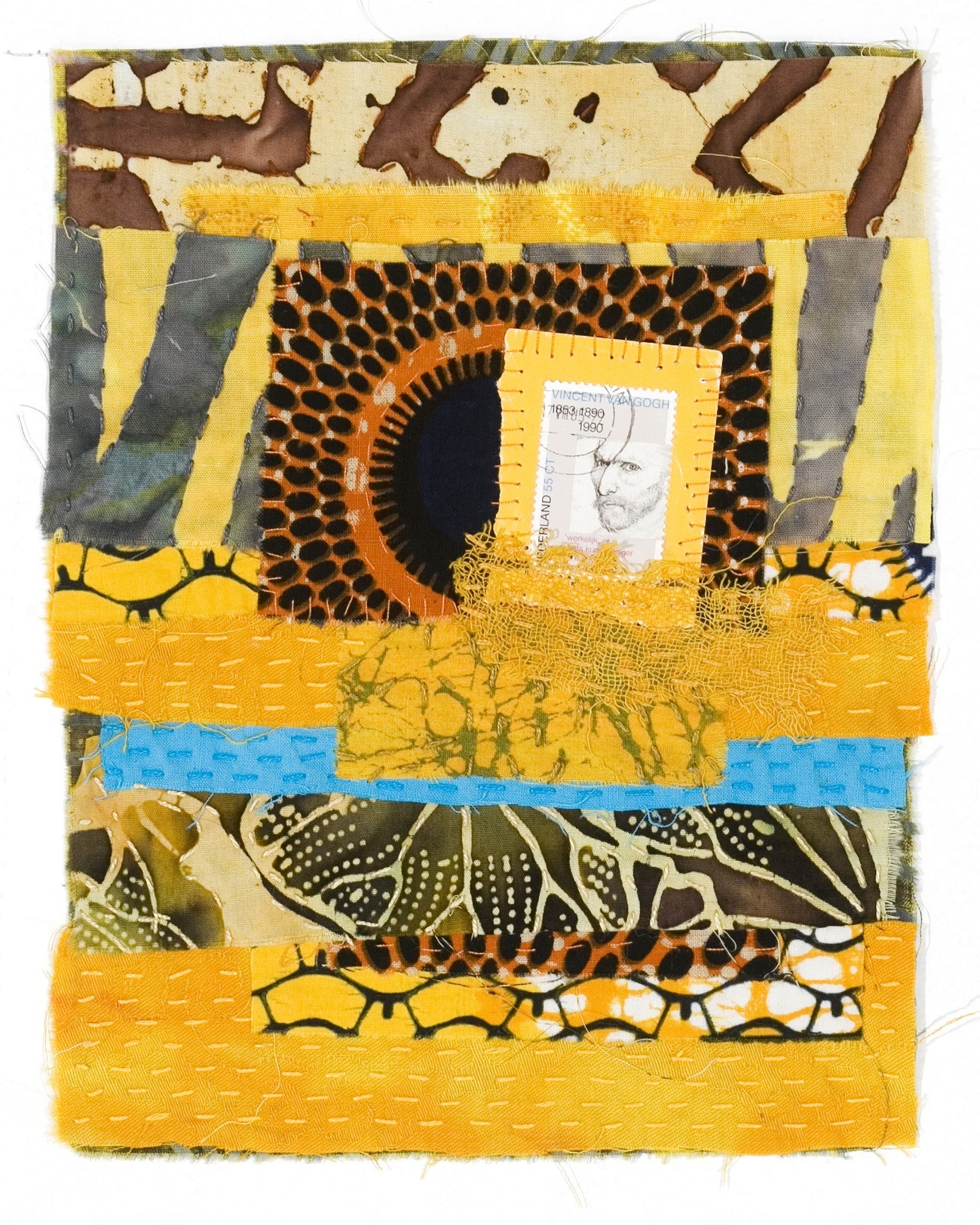
What research did you do before you started to make?
I made up some ‘rules’ for myself. First, the pieces would be the same size (approximately 20 x 15 centimeters), and I would only use left-over fabrics from my stash of scraps.
Additionally, I would also only use hand stitching. And I had to ‘know’ the person on the stamp. If I didn’t know who the person was and what made him or her distinguished, I wouldn’t use the stamp, no matter how beautiful it was.
I wanted to make personal portraits. I did not want to Google anybody, but instead, only refer to my memories.
If the person on the stamp was an artist, I might look in a book or on the Internet to get reacquainted with their work. And if it was a musician, I would play a CD with their music while working on their piece.
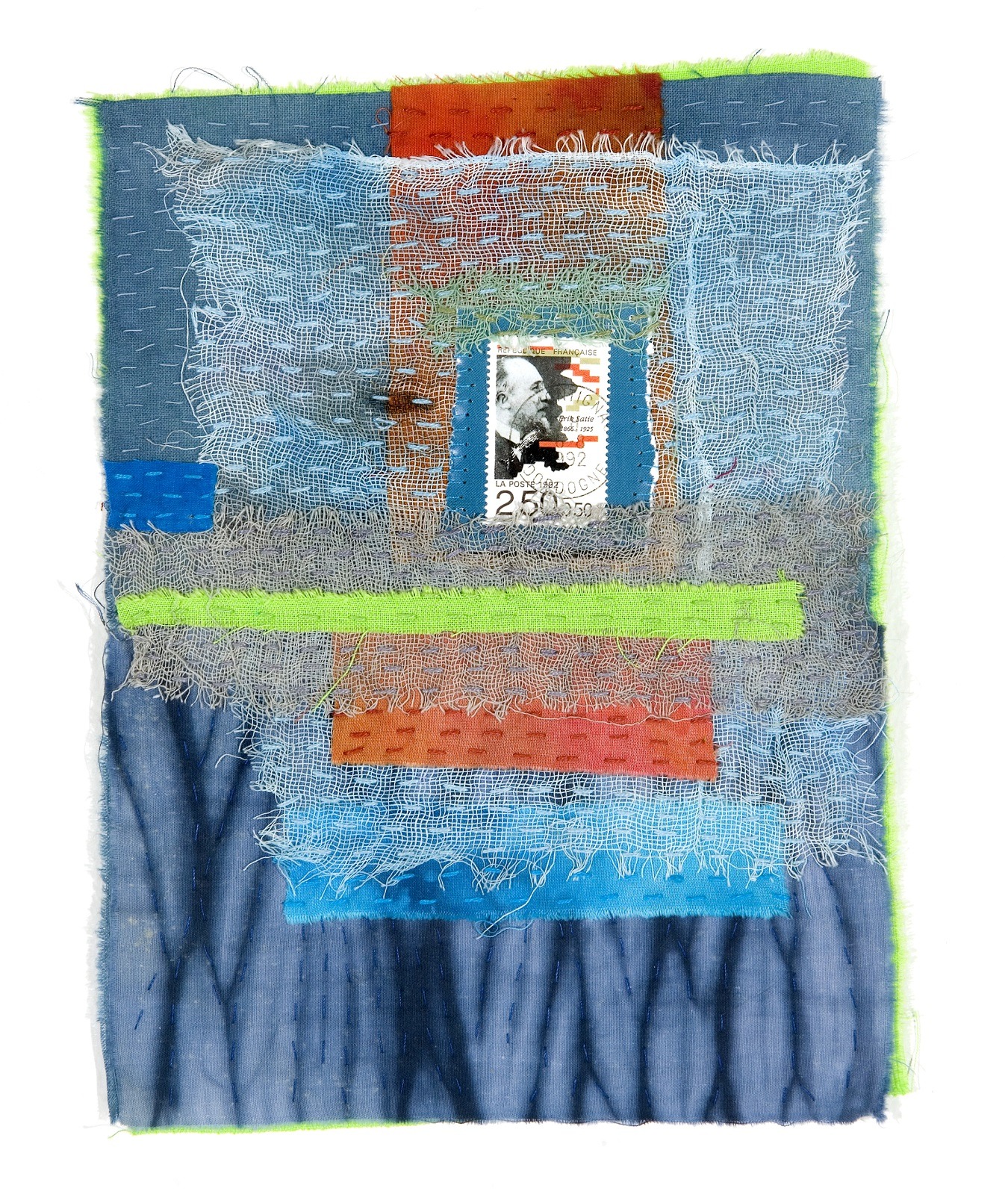
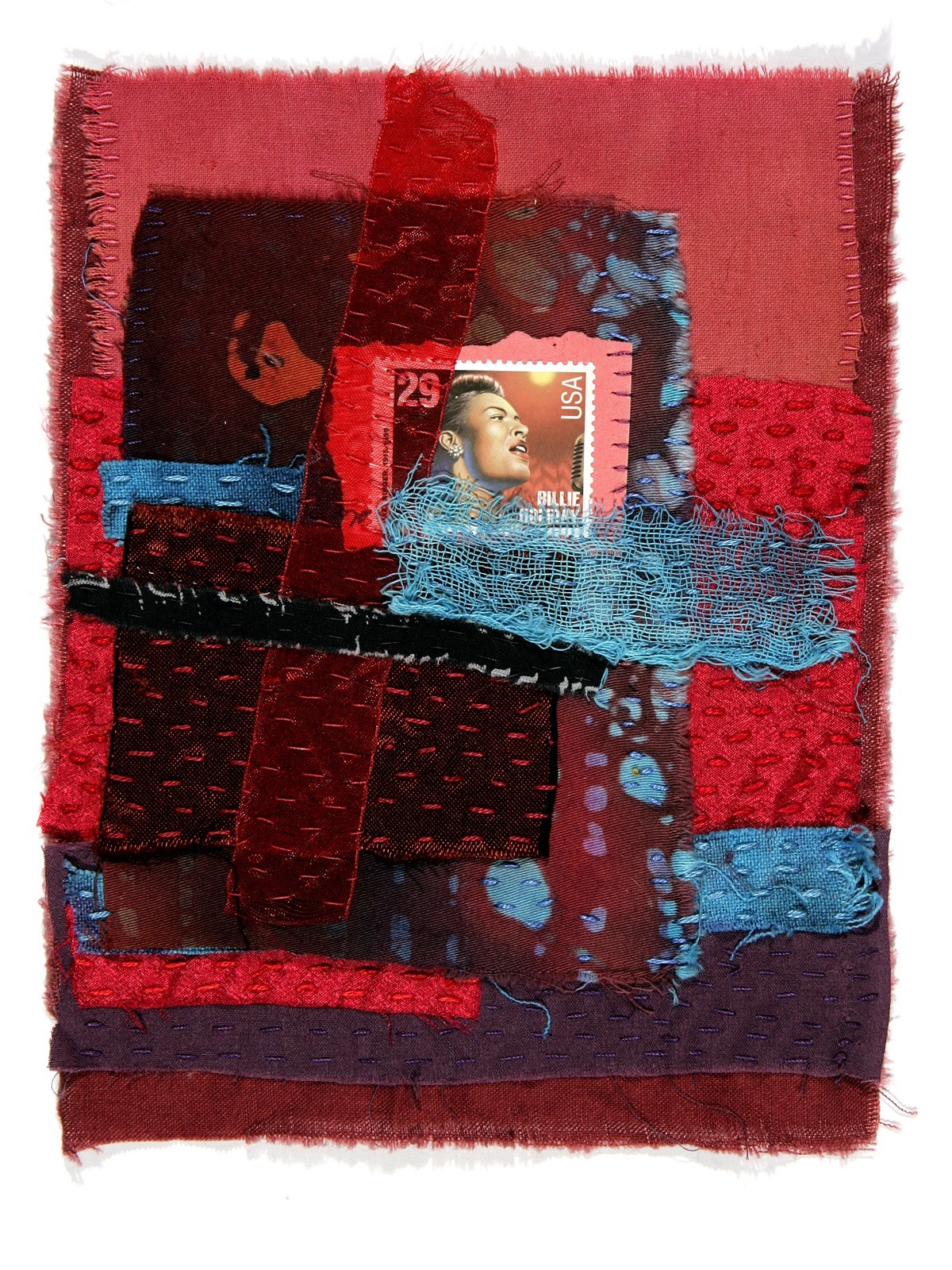
For the love of collage
Was there any other preparatory work?
At a certain point, I found a ‘collectables’ site with stamps on the Internet, and I spent many hours looking for people I didn’t have in my collection. You have to be special to get your image on a stamp, and as a general rule in the Western world, it first happens after you are dead.
I have, however, found stamps of living celebrities from some African countries.
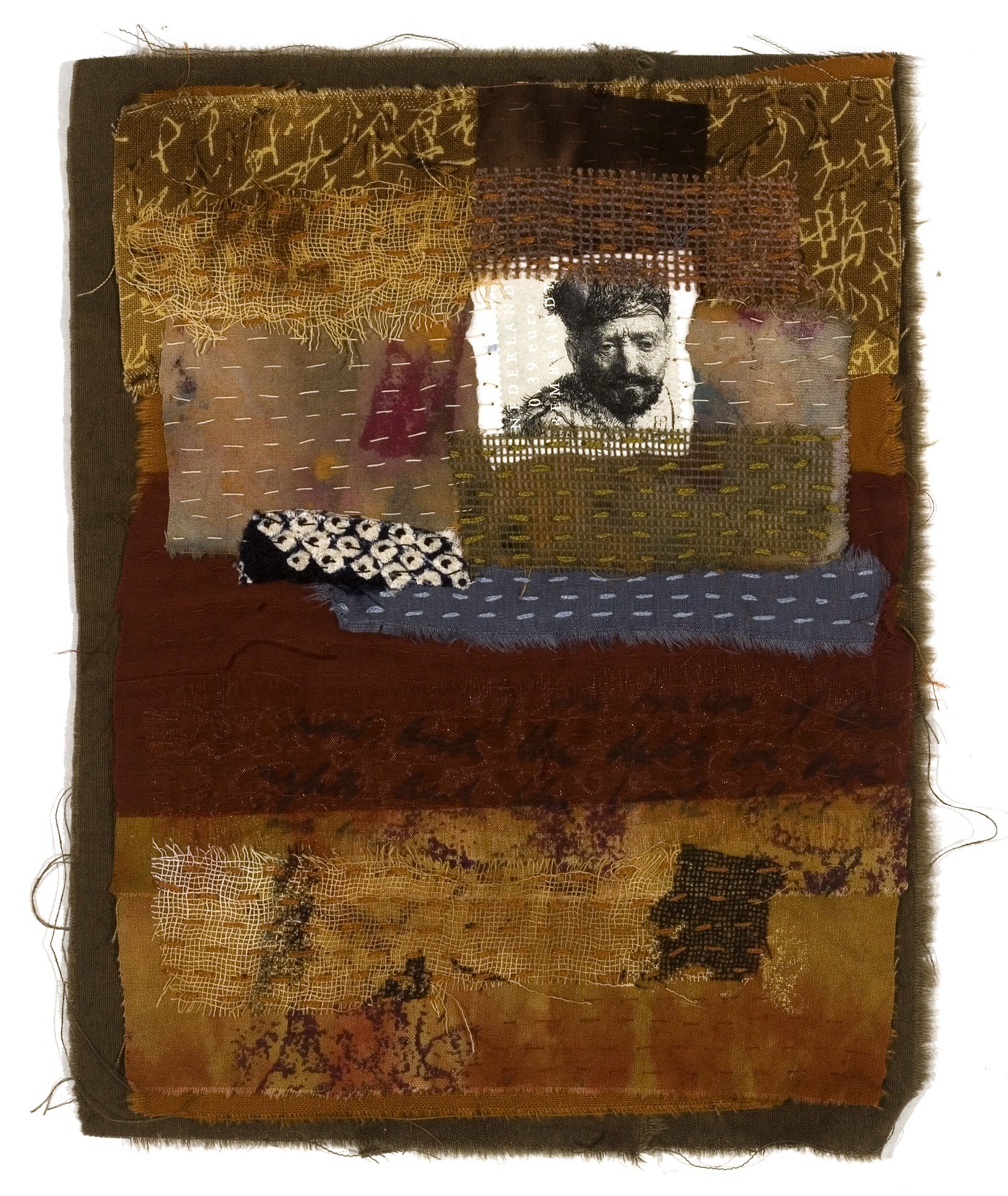
I always work in series, but I never know how big a series will be. I usually know when I have said what I want to say about a subject matter. I don’t want to repeat myself.
But this series is different. It continues to be a challenge, because each person is different and has a different story. And because it is the person that is my inspiration, the series just goes on and on as long as I have stamps that provide me with inspiring and accomplished people.
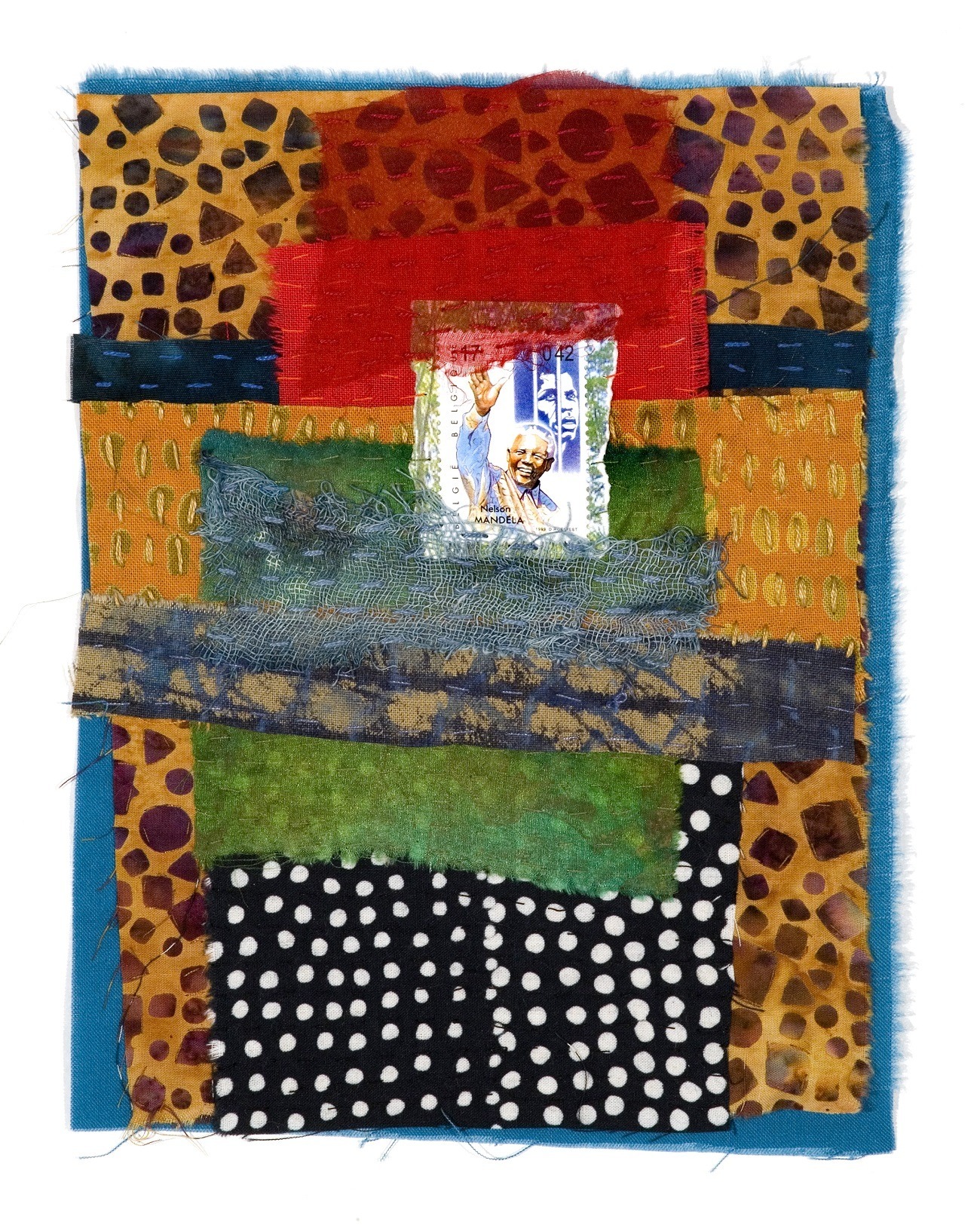
What materials were used in the creation of the series? How did you select them? Where did you source them?
I am a packrat, and I never throw any piece of fabric away. I like the idea of recycling and using my fabric scraps. My stash of leftovers is, after all, my history.
Aside from the environmental and economic reasons, recycling and re-use of stuff that otherwise might be thrown away also opens up a whole new concept of art versus non-art and the idea of beautiful and ugly.
Several periods in 20th-century art history, such as Cubism, Dada and Pop art, have introduced us to non-traditional art materials and to collage. Collage emerged as a fine art medium around 1912, when Picasso and Braques pasted ordinary materials from daily life (newspapers, wallpaper, wine labels, cigarette boxes) onto their canvas. Thus, they changed two-dimensional art forever.
These materials employed their own identity. And instead of being a painted illusion of reality, they had their own physical and tactile qualities.
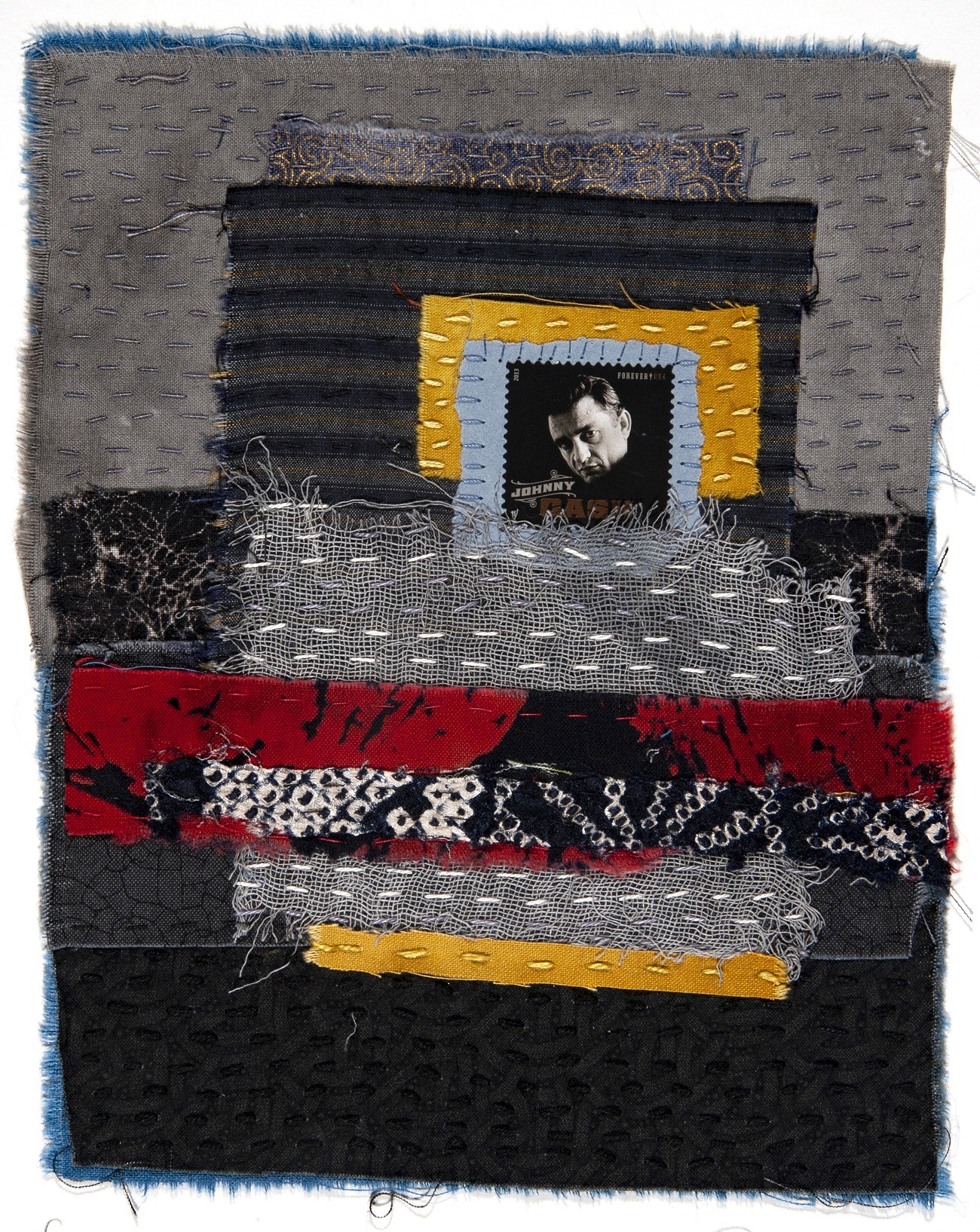
Collage is the ideal medium for me. It is about layering and experimentation, unusual juxtapositions and transformations of images and meaning. To me, no other medium provides such a variety of exciting experiences.
My journalist days were pre-computer time, and I wrote on an old typewriter with no possibility of making corrections and additions. I would print my typed pages and cut and re-cut and paste. I’d often end up with many meters of patched paper that I would then re-type into a normal manuscript.
I honestly think this cut-and-paste way of writing was the beginning of my love of the collage medium.
I work in a similar way with fabric, and I actually still write that way.
For me, the creative process is a physical act. Making art to me is having a dialogue with my materials. The touching, gathering, cutting and tearing is essential. It is about having material in my hands and moving it around until my gut feeling says ‘that’s it.’
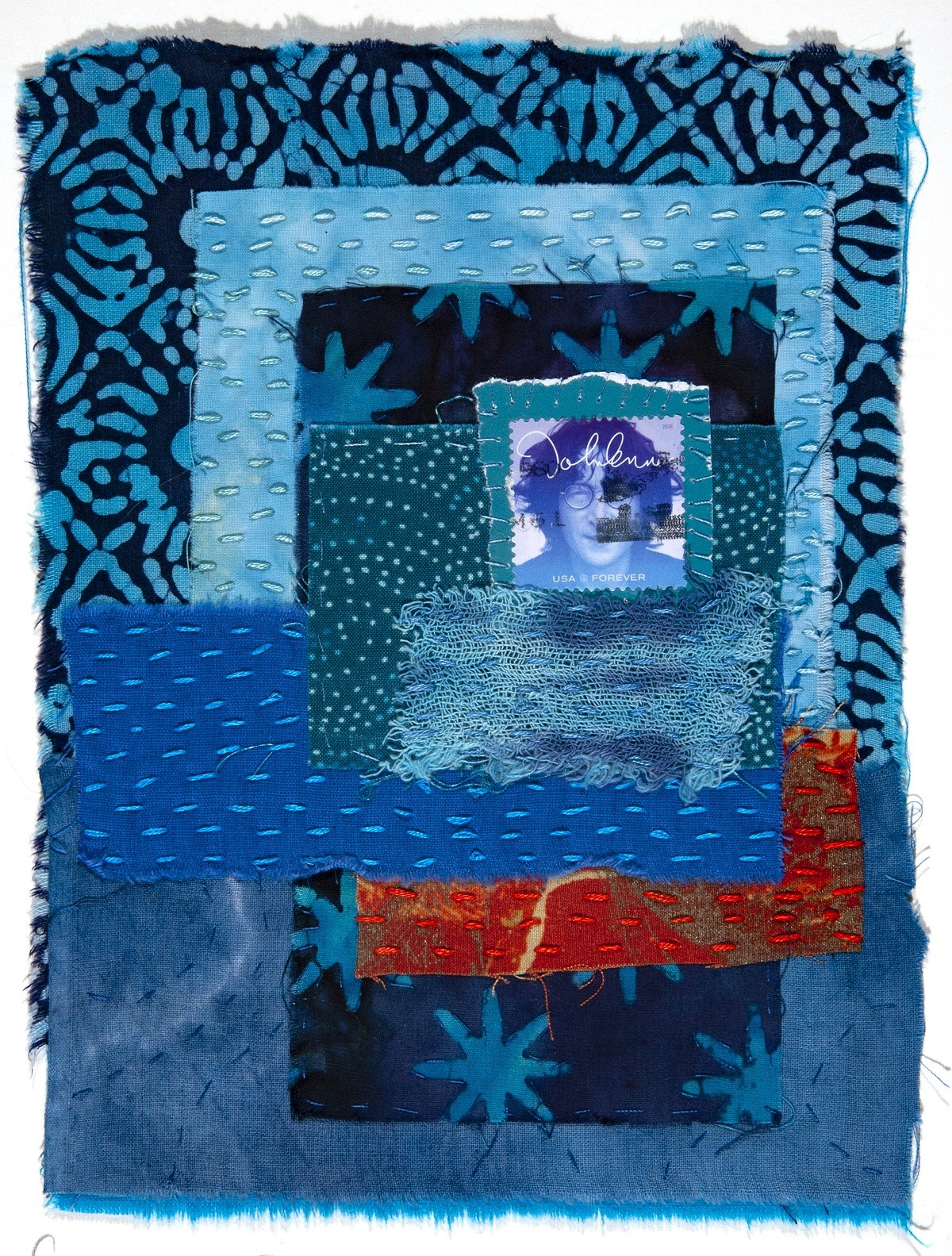
What equipment did you use in the creation of the piece and how was it used?
I only use a stamp, fabric scraps and a variety of threads. I don’t use a sewing machine, and I rarely cut anything. I often find just what I need in tiny scraps.
When the piece is finished, I mount it on heavy paper with double-sided tape.
The stamp—or rather the person on the stamp—is the focus of the piece, so I start with glueing the stamp on a piece of paper in a fitting colour. That way, I can stitch in the paper and not in the stamp. (And after all, stamps are usually glued onto a paper envelope.)
I then smear a thin layer of acrylic gel medium on the stamp, which will seal and protect the paper.
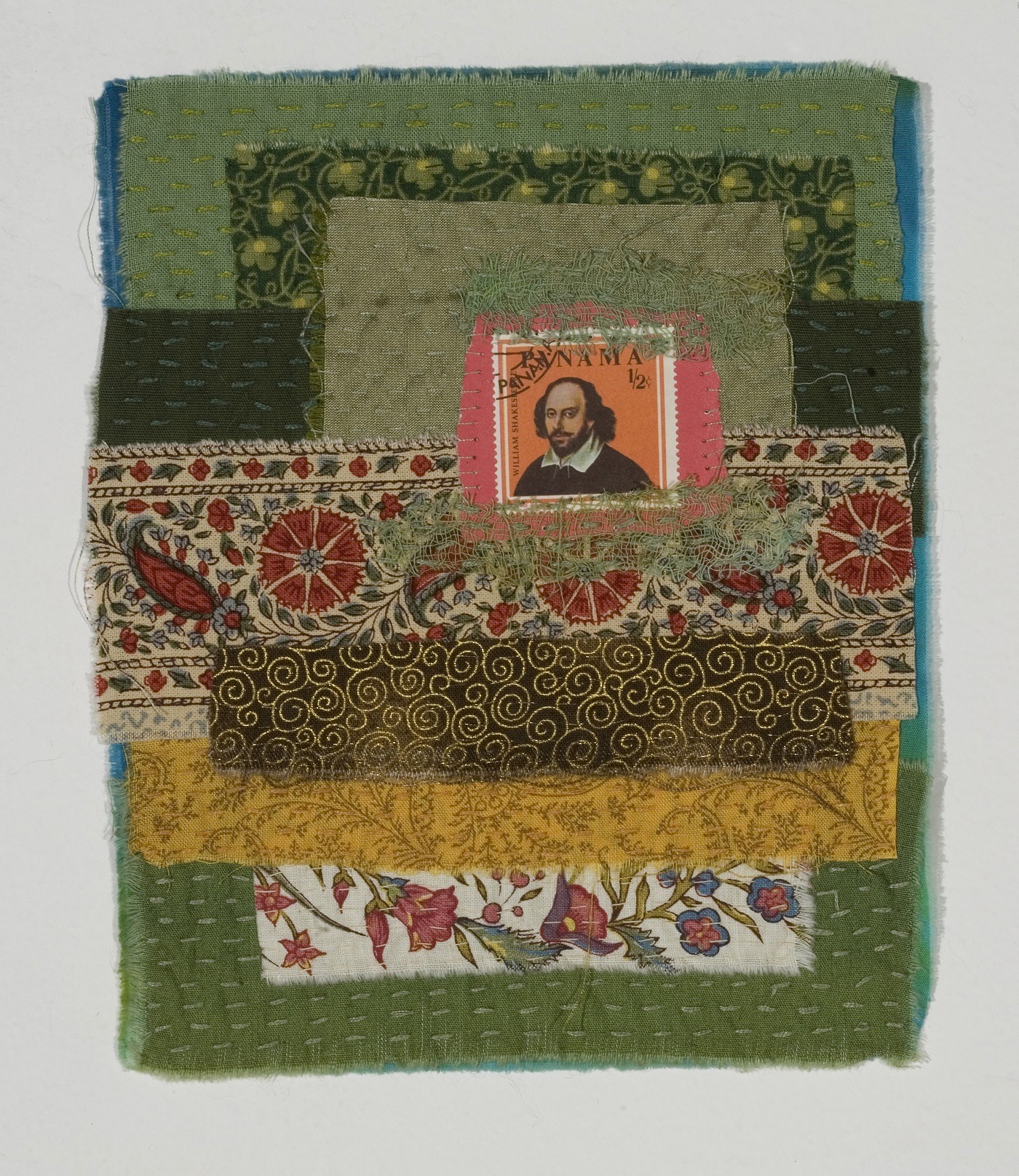
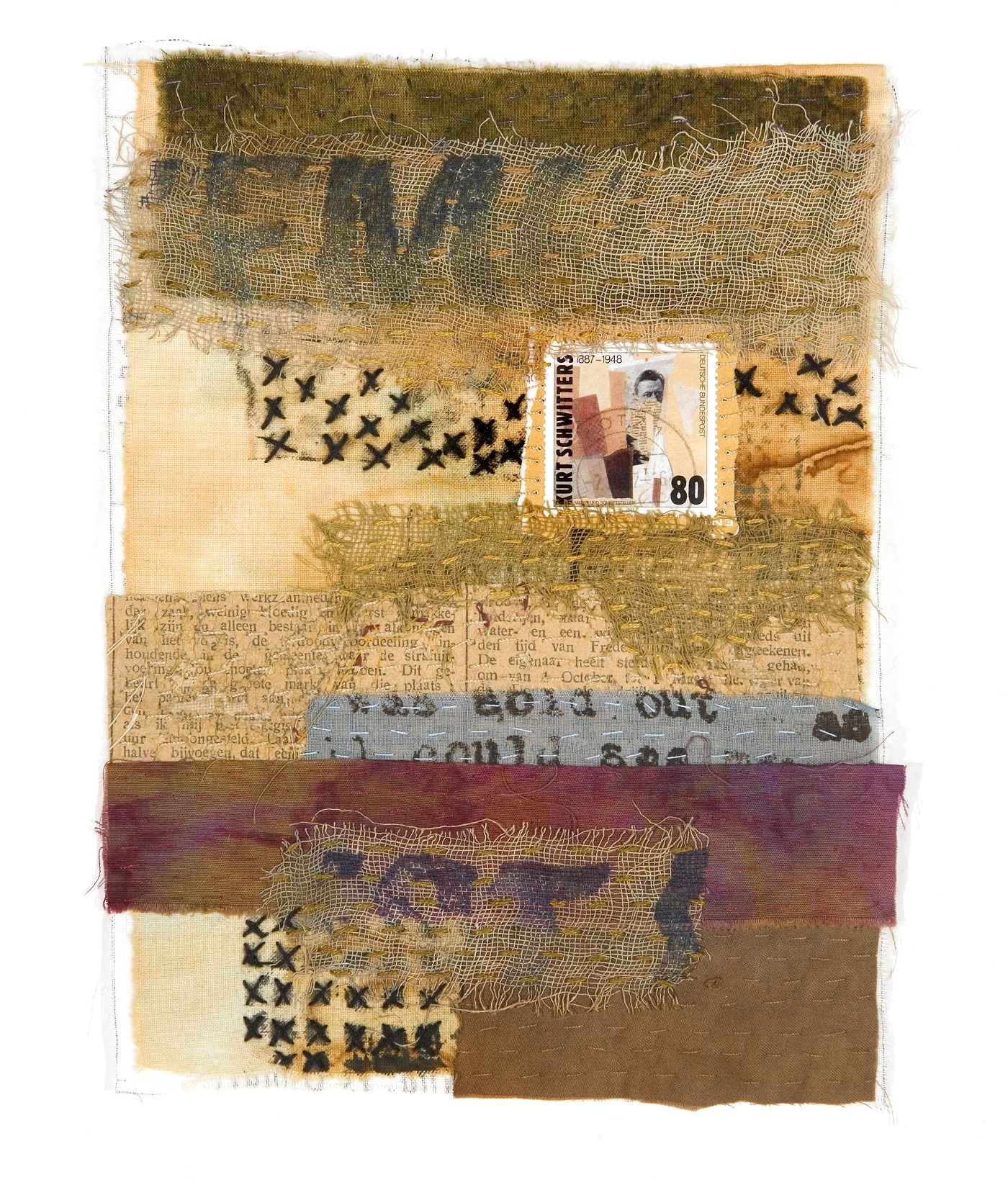
The power of ‘limitations‘
Take us through the creation of the piece stage by stage
I keep my fabric scraps in plastic bags according to colour. When I decide which stamp I’ll use, I think about the colours that go with that person.
I then start making piles of ‘maybe’s’ from the scraps., mainly cotton and linen and fabric I have printed, screened, rusted or discharged. I always end up with a much bigger pile than I need.
I have to have enough from which to choose, but when I have made a pile, I’ll only use from that. I’ll not be searching for other bits and pieces and wasting a lot of time.
We all love colours, but colours can be very seductive and easily make us neglect other aspects of design, such as line, shape, texture and value. Too many choices makes you lose focus.
It may sound contradictory, but I am convinced ‘limitation’ is freedom for creativity, and it makes you work more purposefully.
I then choose a piece of backing fabric, deciding on a colour that will show up at the edges. And then I start moving the tiny pieces around until the composition feels right. I don’t use any batting or wadding, because there are enough layers to give the piece stability.
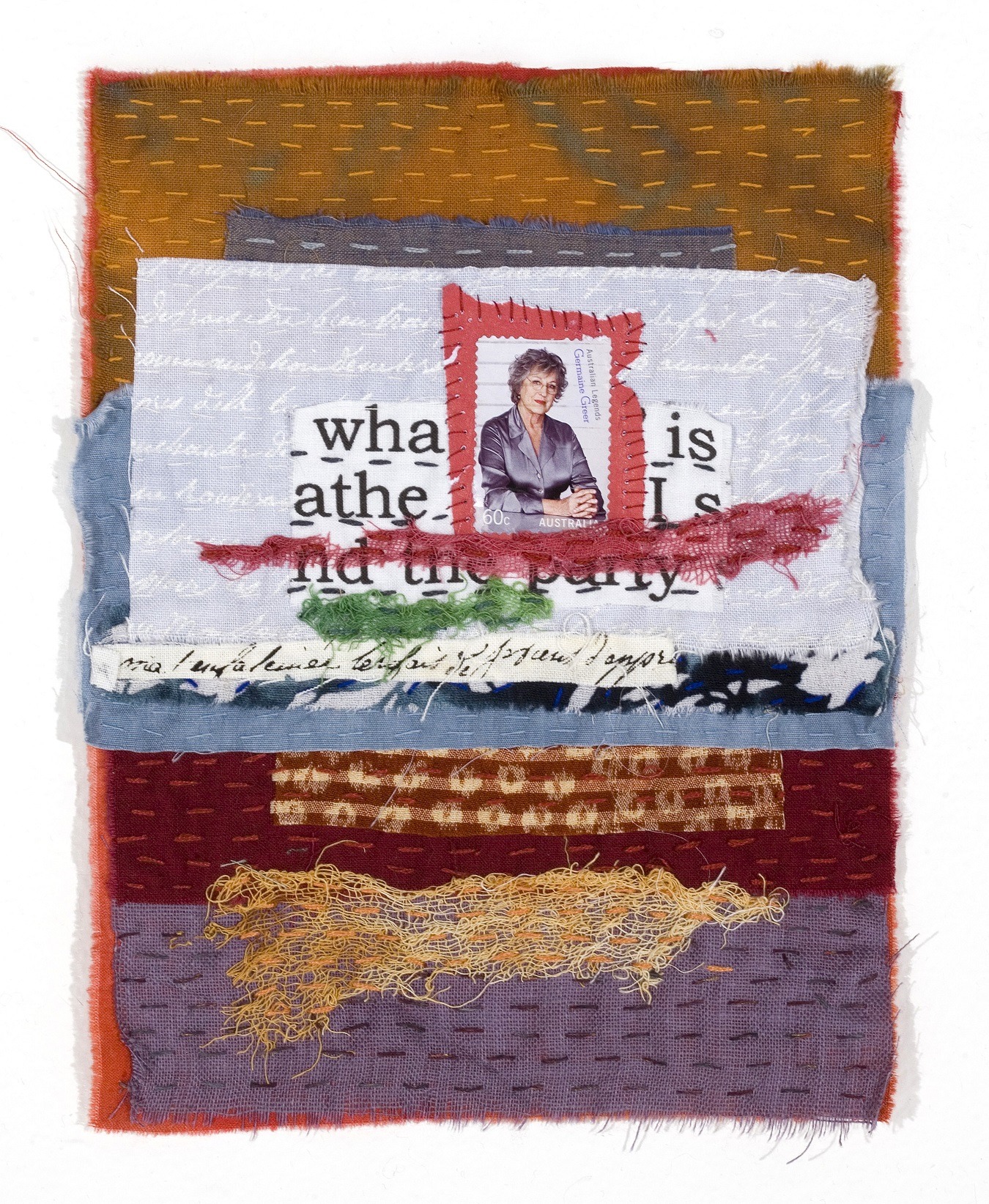
When I am happy with the arrangement of colours, shapes and textures, I pin all the pieces together, and then I let it rest for a day or two. It’s a way to sort of ‘sleep on it’ in order to look at the composition with fresh eyes.
The next step is to choose threads and colours for the stitches. Collaged together with hand stitching, this process becomes an intimate conversation between me and the depicted person.
I am not really an embroiderer. My favourite stitch is the simple running stitch. It serves as the functional element of holding the fabric scraps together, as well as makes an expressive graphic mark on the surface.
Sometimes I’ll use the back stitch, the buttonhole stitch, seed stitch and cross stitch.
I don’t bind or machine stitch around the border. I like the raw edge and a certain amount of ravelling. It gives the piece textures, defines the edges and provides a tactile quality.
These ‘Small Notes’ present a cultural insight into the 19th and 20th centuries. But I have discovered it is not just about the people on the stamps. It is also my history and the history of the time in which I grew up.
These are the people that have influenced me: the authors I have read, the artists whose work I have admired, musicians I have listened to, and the heroes and icons I have grown up with. From Ann Frank to Mandela, and from Billie Holiday to Kafka.
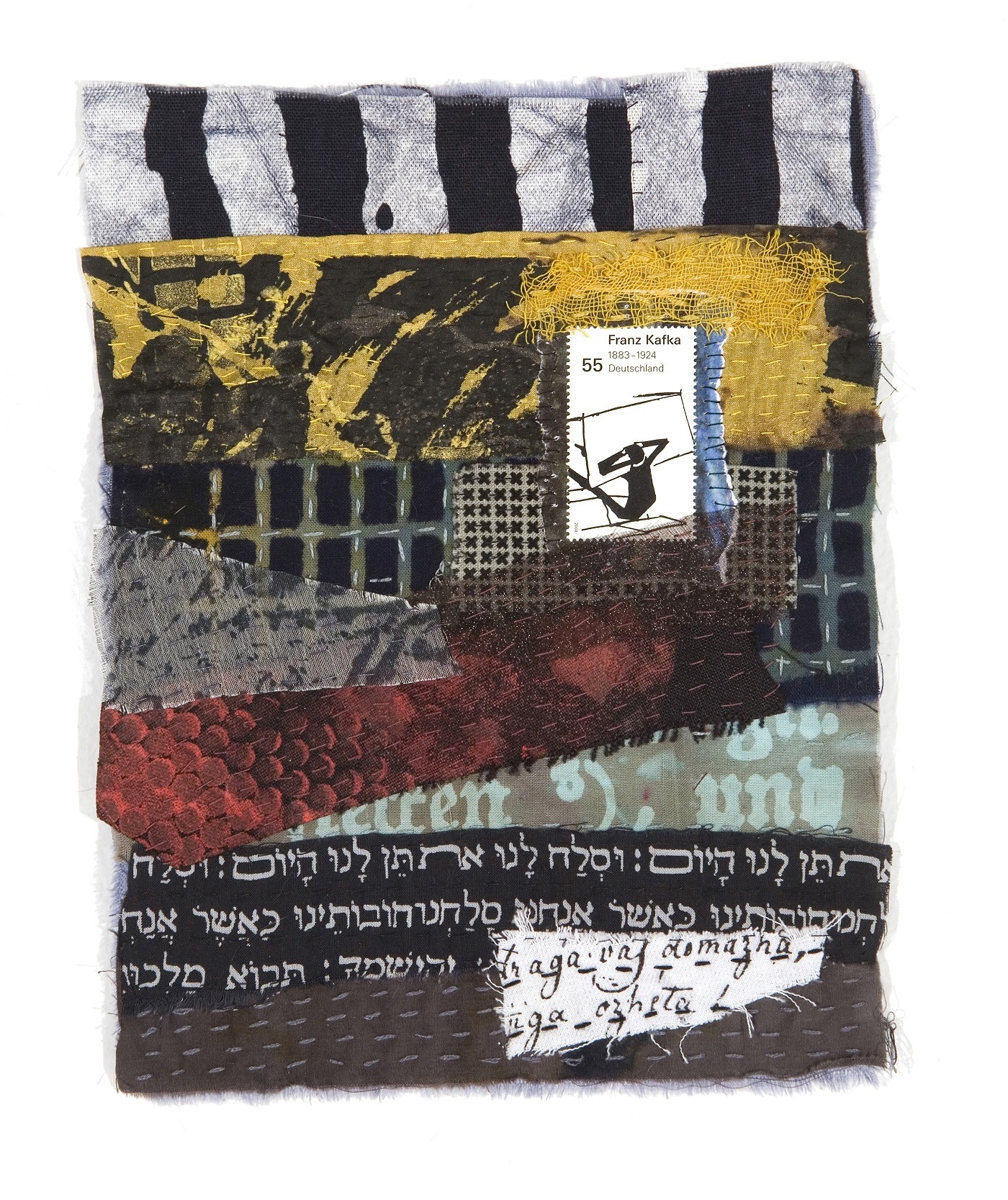
What journey has the piece been on since its creation?
In 2010, when I had made 156 ‘Small Notes,’ I was invited to show 100 pieces in an exhibition in Lugano, Switzerland. I decided to document the series and make a book as a sort of catalogue to accompany the exhibition.
I hadn’t planned on stopping with the series, but then I thought maybe 156 was a good number, and that the exhibition and book together would be a nice closure.
But when I sold almost all the pieces and got home, I had the feeling that ‘all my children had left home,’ so I decided to continue the series.
I have now finished Number 356 with Marvin Gaye, and I still have hundreds of stamps waiting to be turned into a small portrait.
I have shown the ‘Small Notes’ in other exhibitions, but never more than 10-12 together. It would be nice to one day have another exhibition at which 100 of them could be shown.
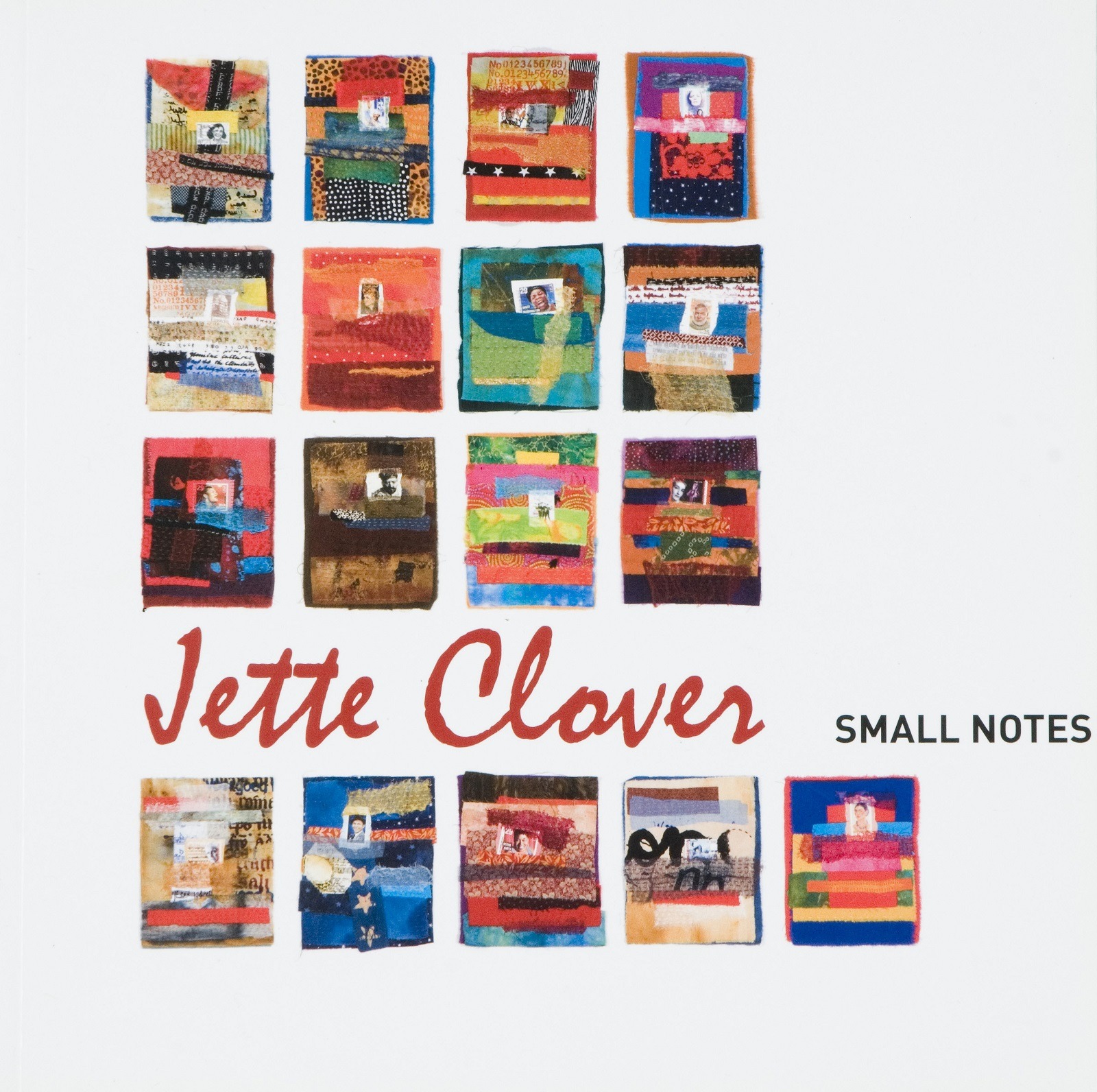
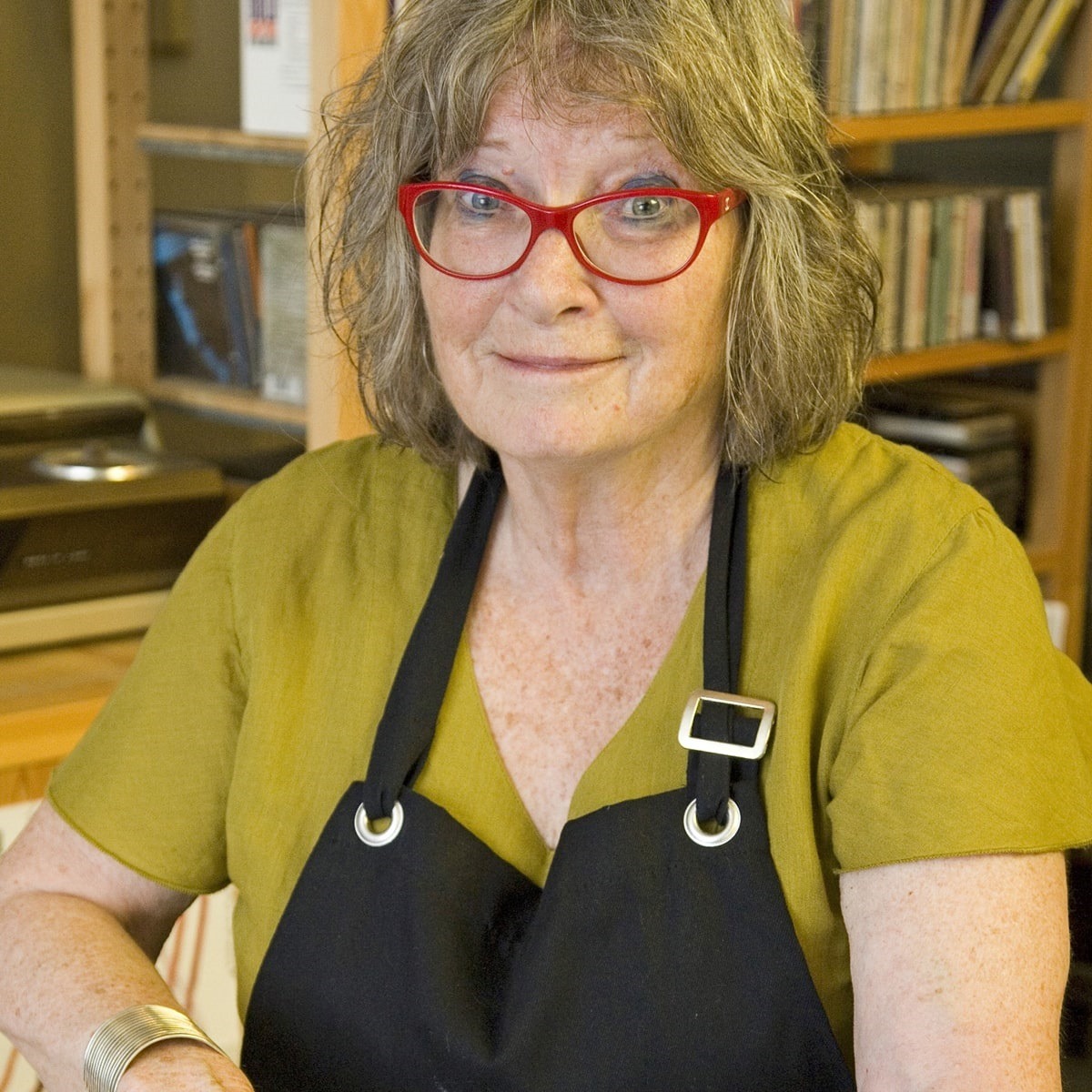
For more information visit www.jetteclover.com
Jette infuses her personal hobby (stamp collecting) into her art. How have you incorporated a personal hobby or interest into your own art? Let us know below.
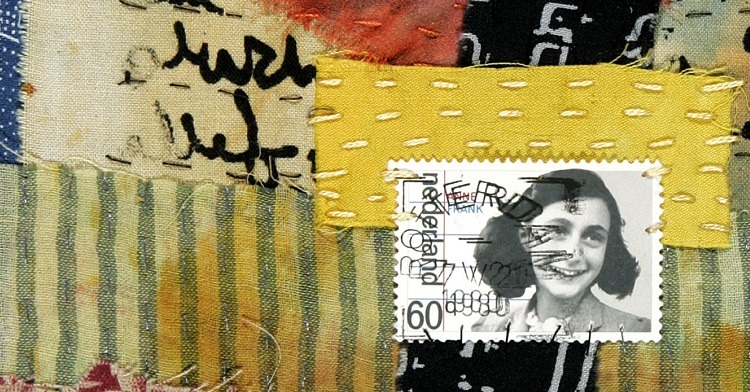
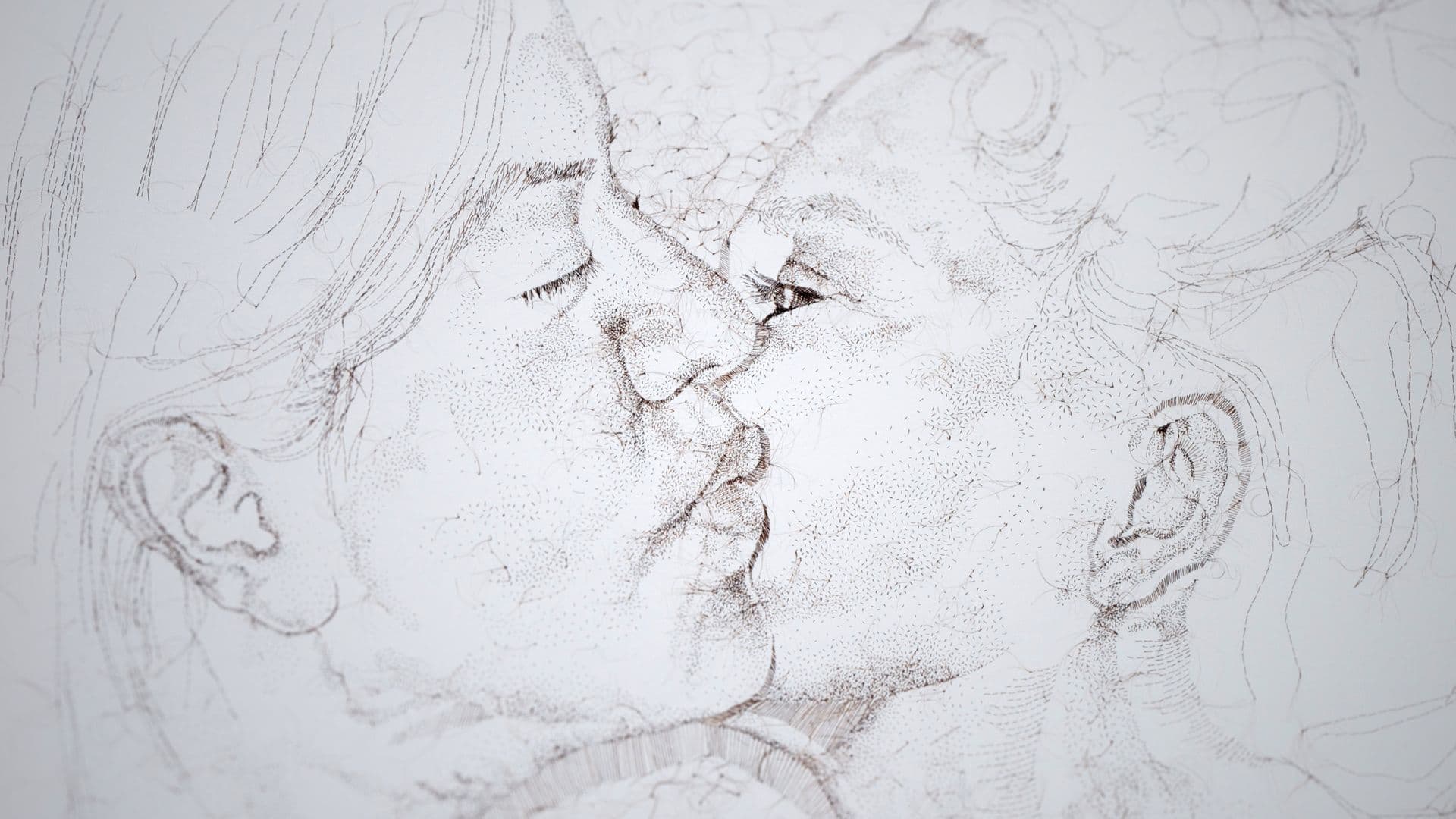
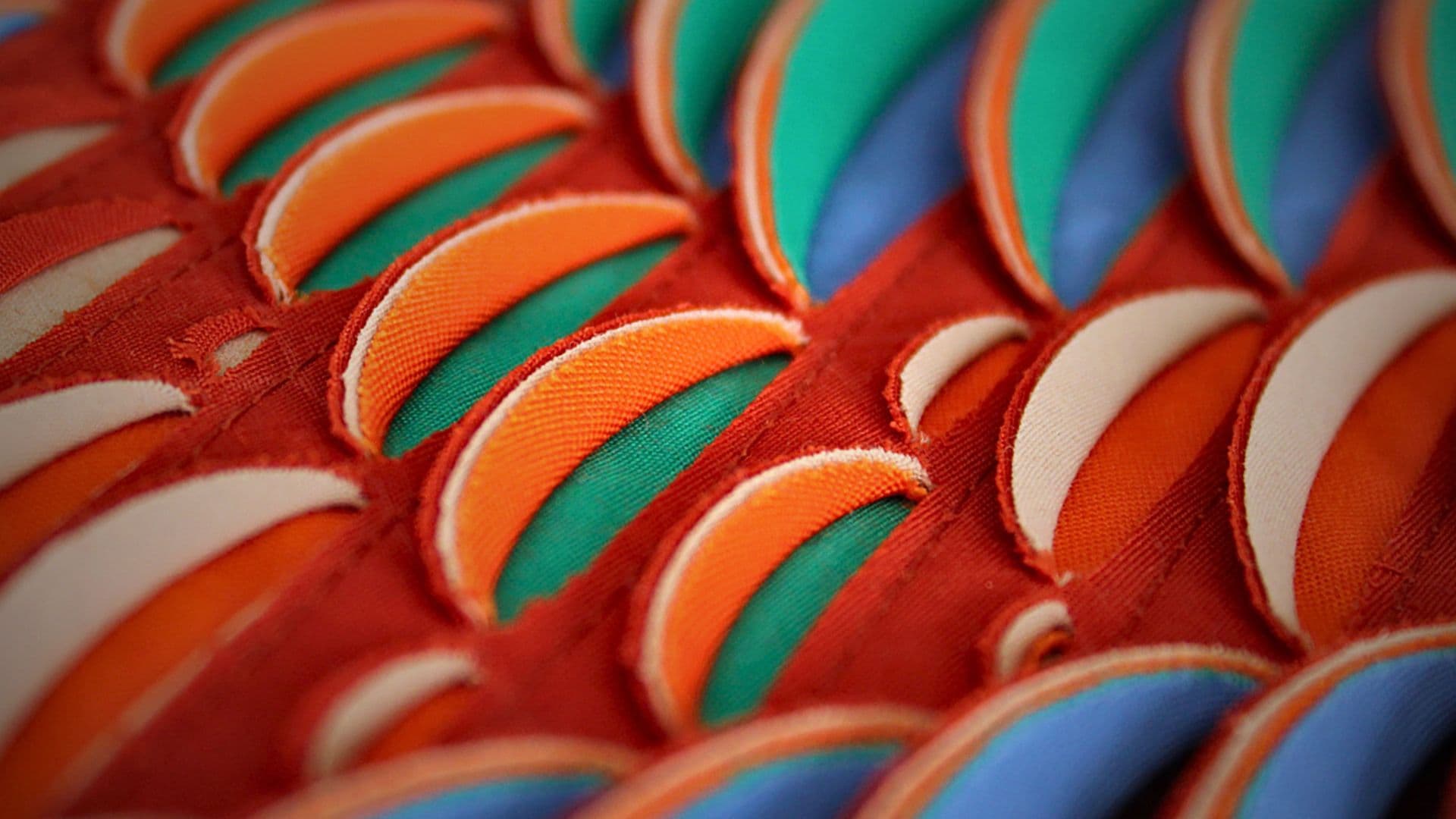
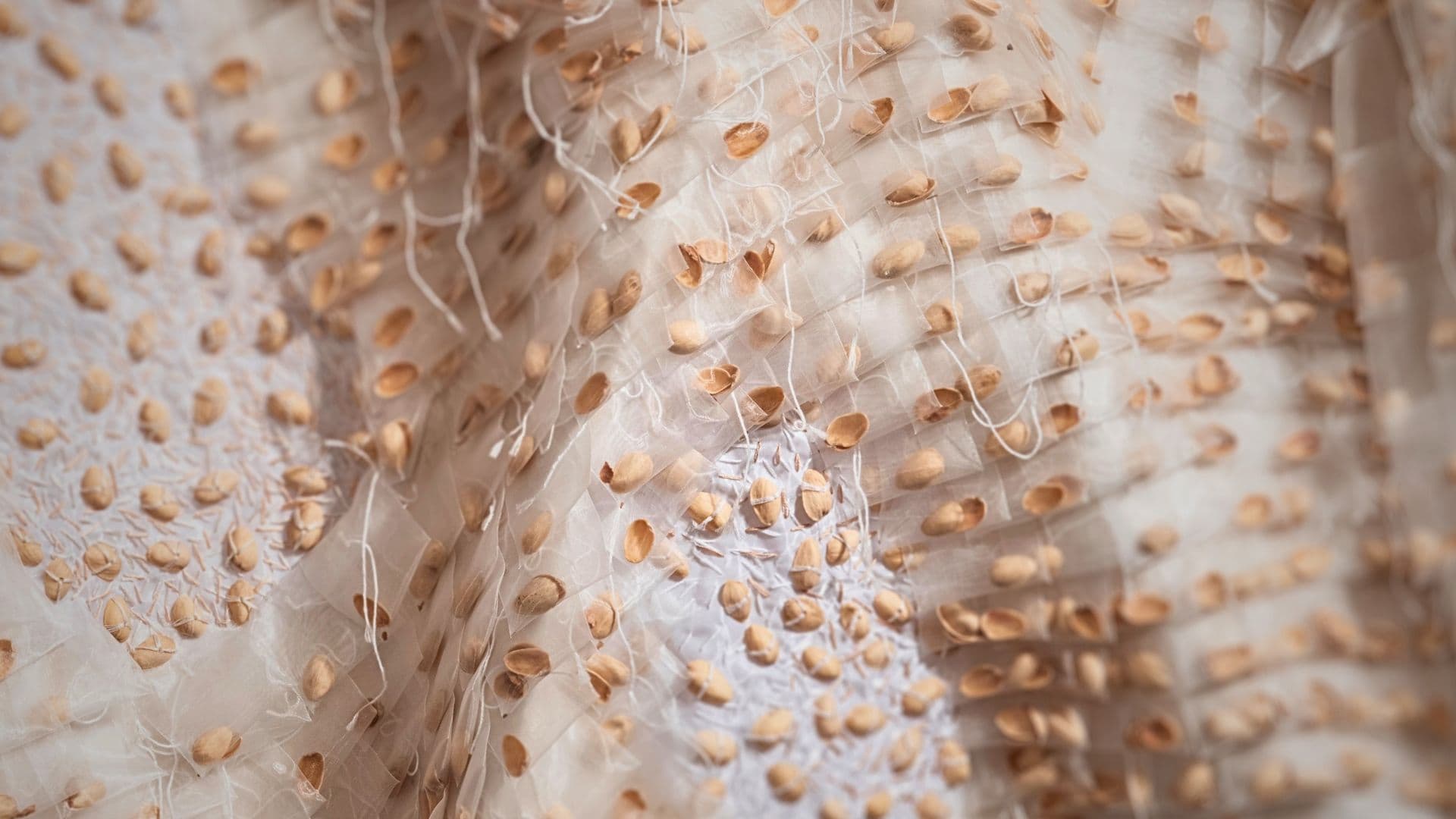
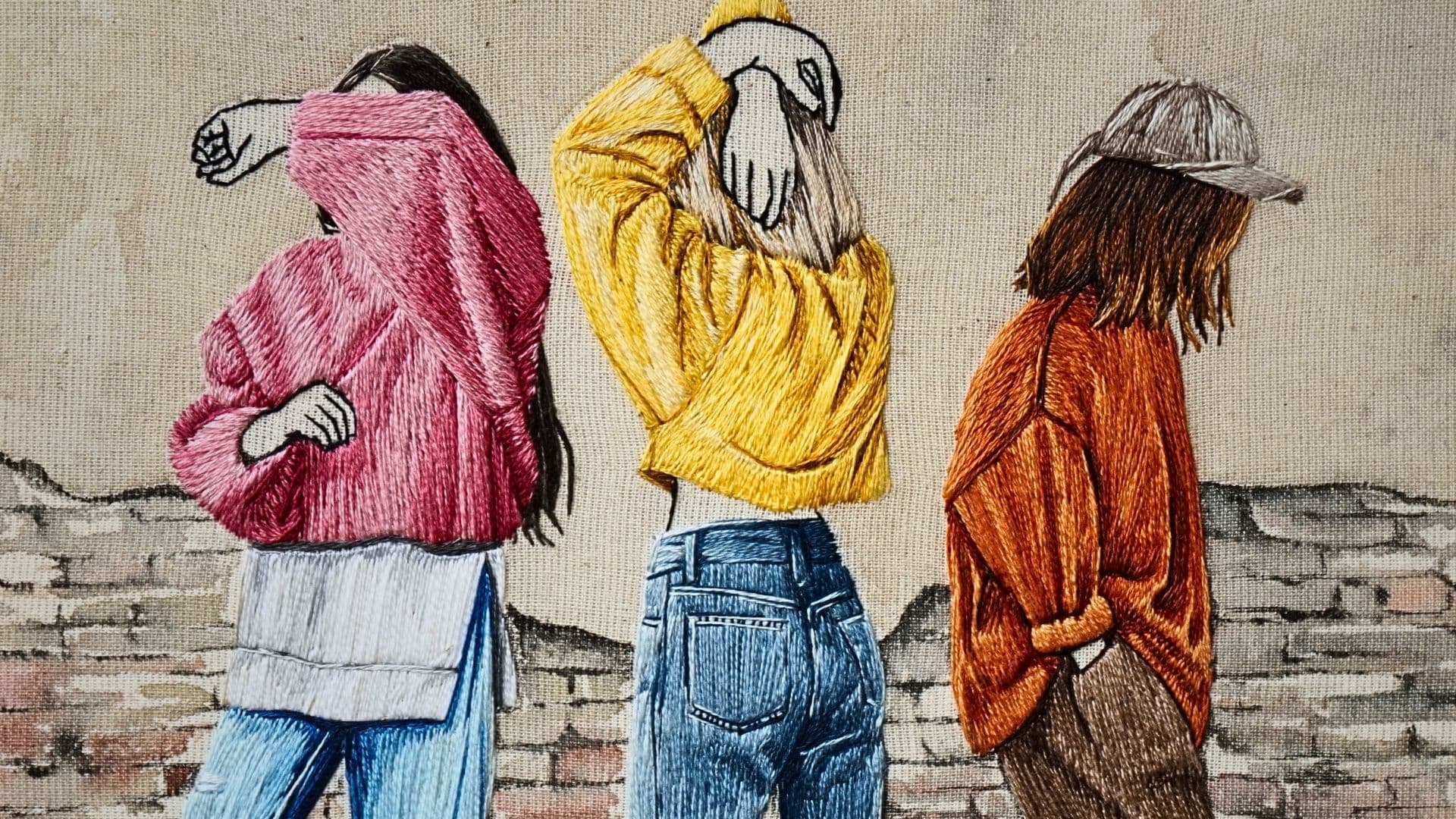
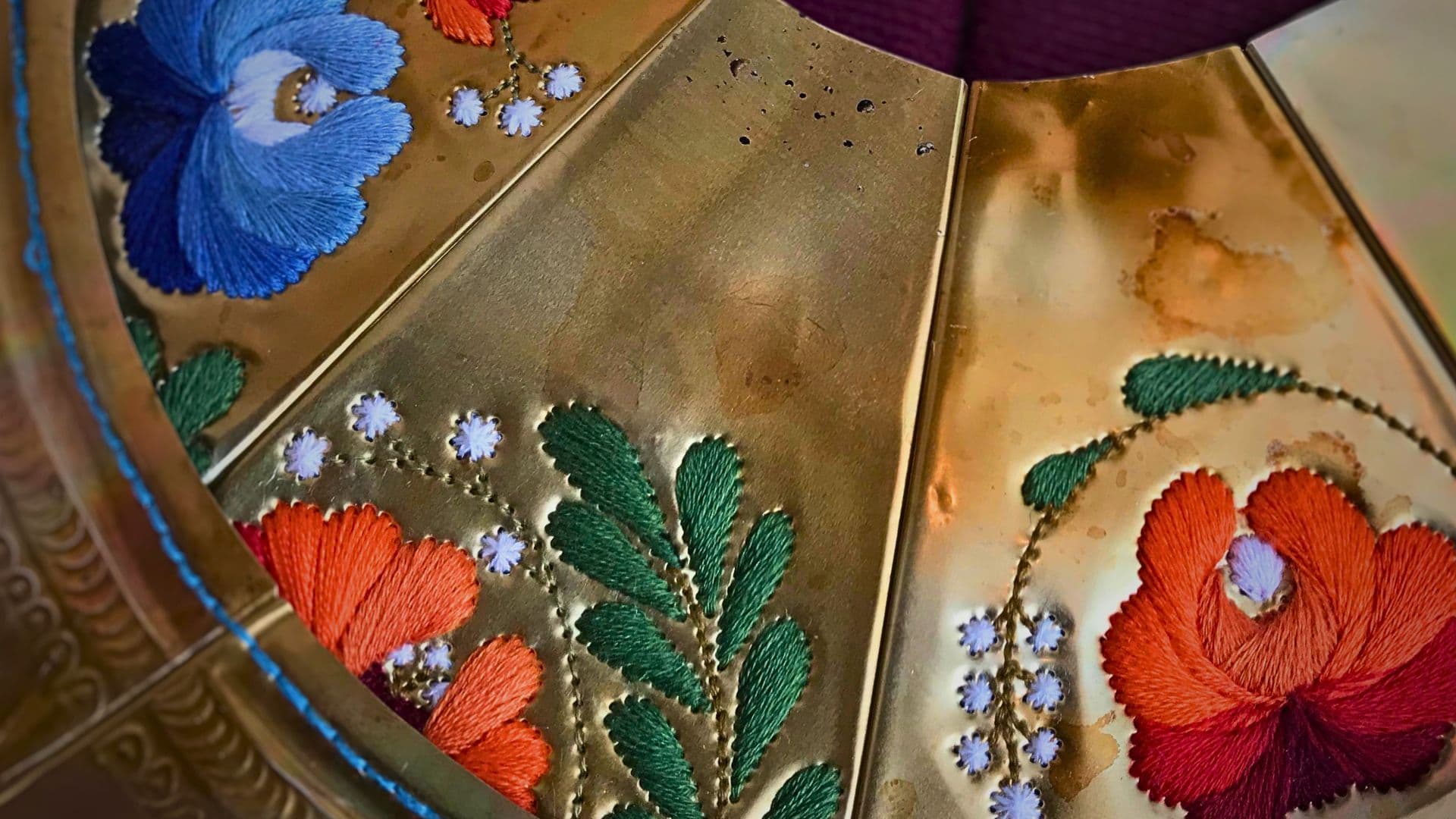
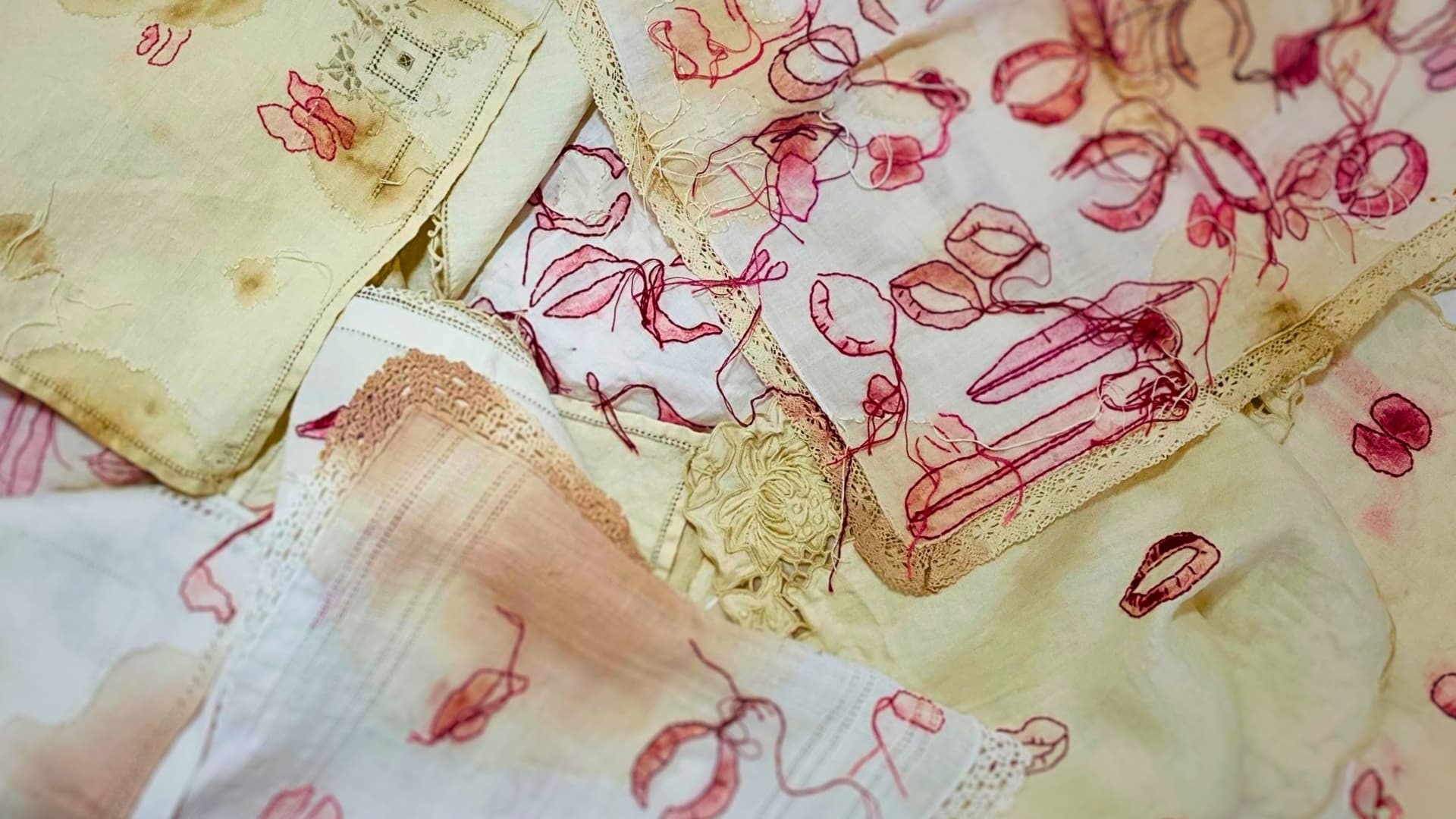
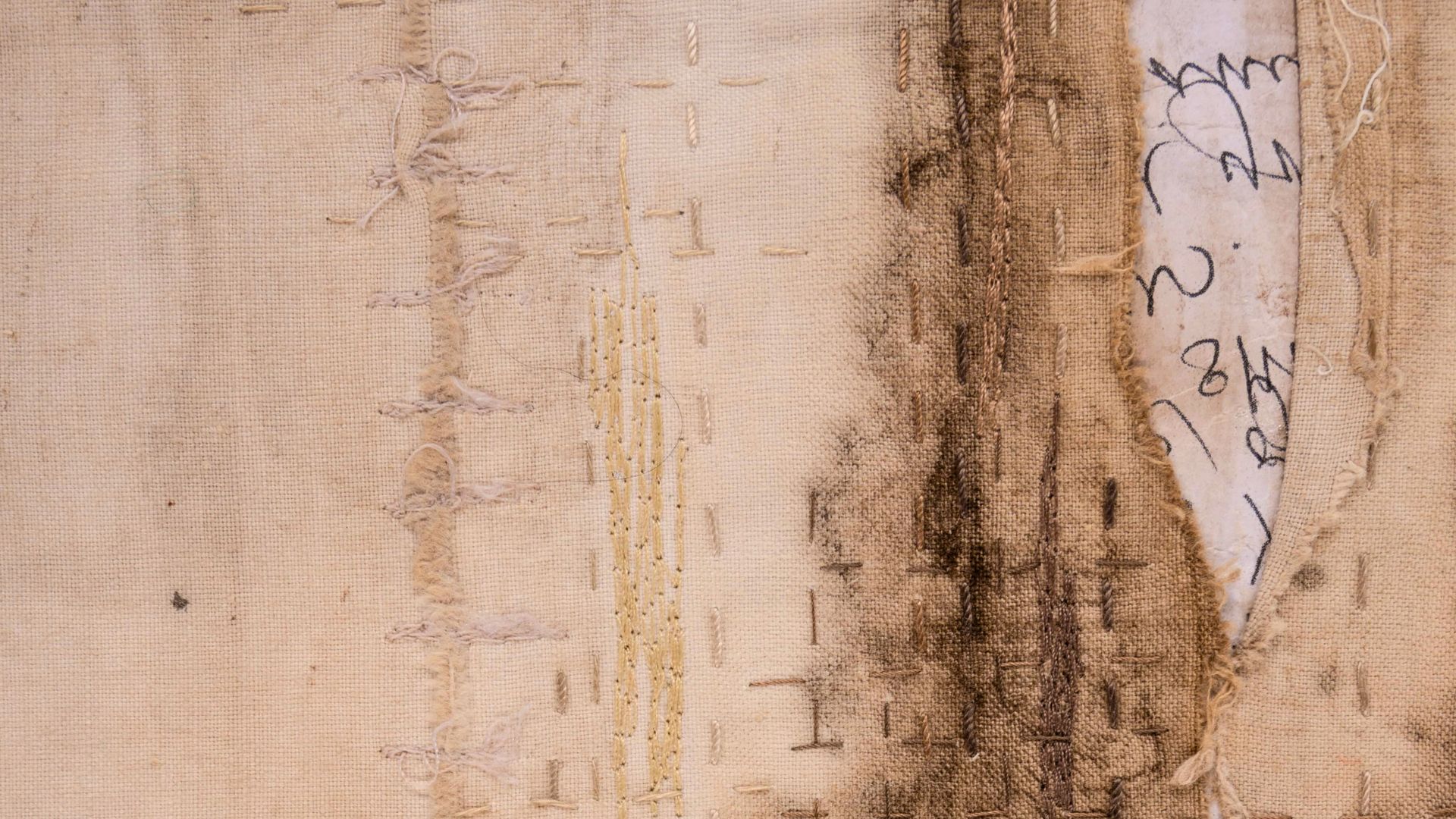
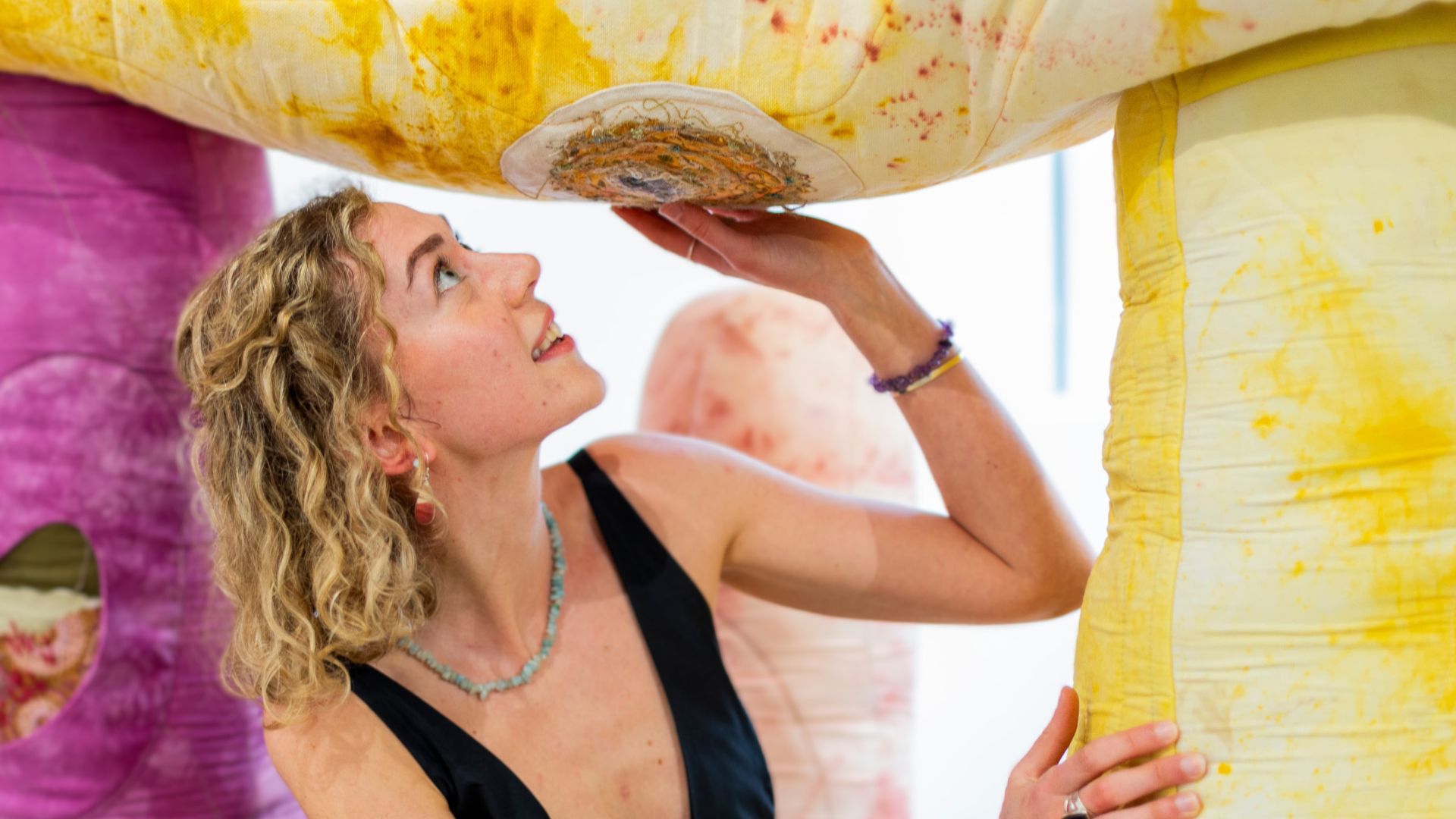
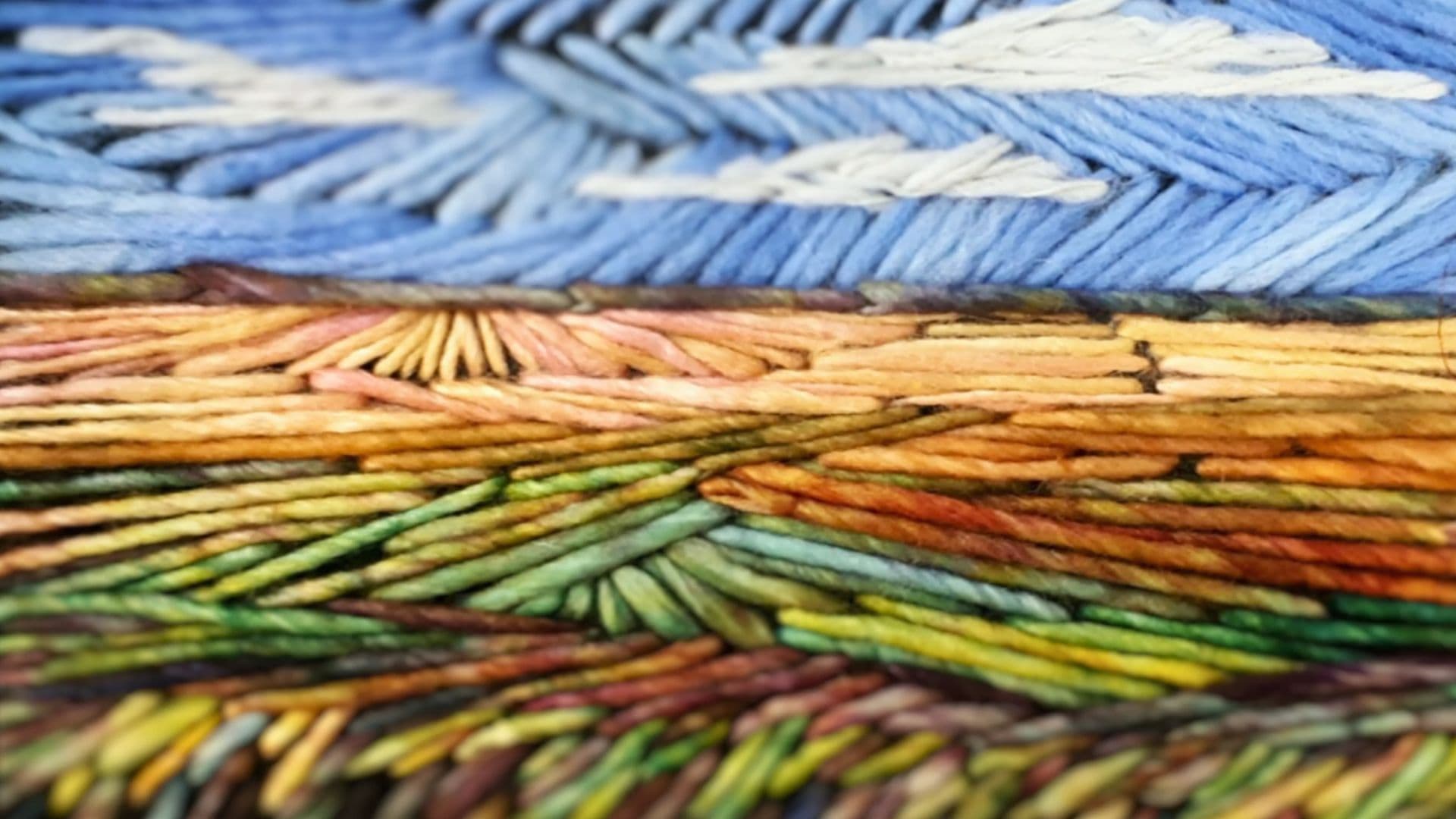
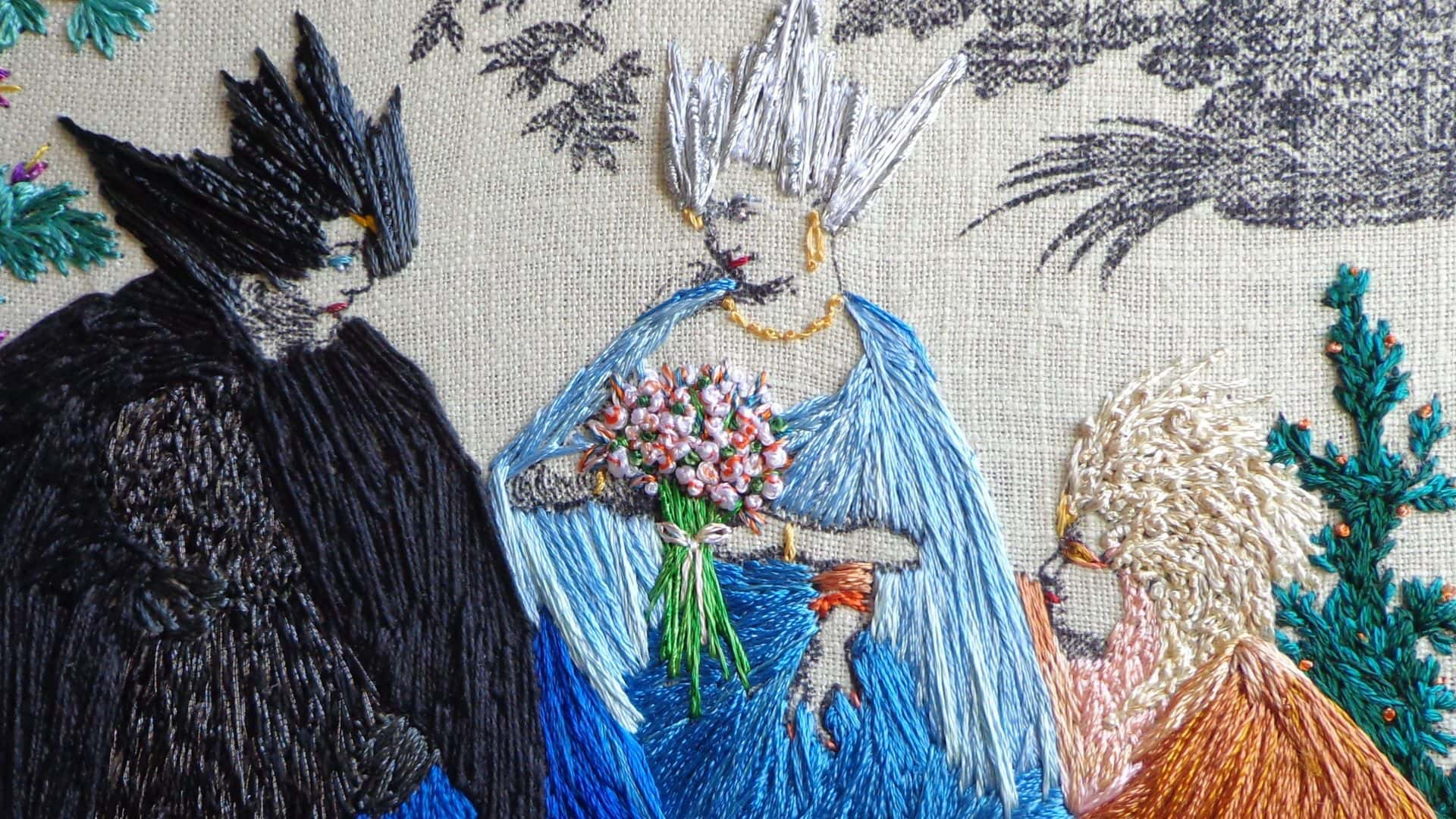
13 comments
Lia overman
So enjoyed this article about Jette
Having her as a teacher in Perth W Australia was fantastic and I feel so inspired once again
To start working after a long stagnant period
Thank you for lighting my fire once more!!
Janice Fried
I loved this interview with Jette Clover. Working in a series like that is such a good way to keep oneself always motivated. I wonder if there is ever an issue with using stamps as far as copyright?
Vera Kassühlke
So beautiful!
There is a question which bothers me: I’m a graphic designer and love making collages. I also collect stamps to work with, but I’m not sure what to do about the copyright of the designer of the stamp. Can you sell a piece which consists in part of work from another artist? I have the same concern with using gift wrapping paper or wall paper. I would be very grateful to learn how Ms. Clover handles that or for any advice. Thanks in advance!
Karin Norunn
Thank you for this very inspiring article. My mind starts to “run”.
Claire Riggall
A lovely article and what an environmentally friendly way to work – recycling both stamps and fabrics. So much more imaginative than trapping stamps in an album or, worse, leaving them unsorted in a box.
Terri Bryson
These newsletters are terrific!!
I especially like the Jette combines her art with a loved hobby. She does create a personal history. Quite an inspiration!!
Rose
What a great inspirational article! Thanks for giving this to us!
Pam buck
Deceptively simple beautiful collages, fabrics so cleverly chosen to illustrate each person. They really resonate with me, they feel very personal but accessible and inspiring. Thank you for this lovely article.
linda litchfield
What an inspiring start to the week! What an amazing woman and what wonderful work.
Cas Holmes
Fabulous work and I am delighted to own a piece, and love my Frida Kahlo. xx
Val Marshman
What fabulous work, so so effective.
Helen Cooper
A wonderful piece of writing. It resonated so much with where I feel my work is progressing and in that way, extended my thinking. Thank you so much.
Margot
What a glorious article and such gorgeous, inspiring work, thank you